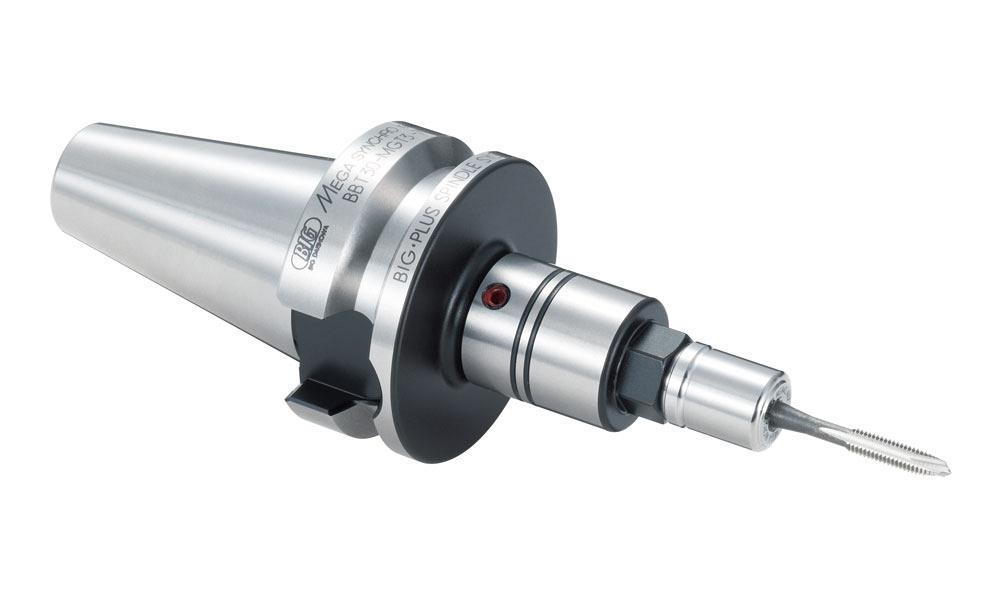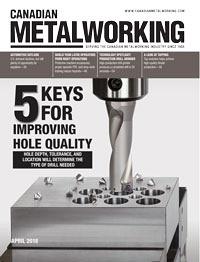- FMA
- The Fabricator
- FABTECH
- Canadian Metalworking
A look at tapping
Tap evolution helps achieve high-quality thread production
- By Canadian Metalworking
- April 26, 2018
- Article
- Cutting Tools

Mega Synchro holders, like the MGT3 from Big Kaiser, provide high radial stiffness and precise runout, while allowing a few thousandths of axial float to compensate for variations between the tap and the synchronized speed and feed of the spindle. Photo courtesy of Big Kaiser Precision Tooling.
Tapping is a fast, economical way to create threads in a drilled hole. As technology improves, both in the machine tool and the tooling, it will continue to be popular for creating internal threads for years to come.
Canadian Metalworking (CM) recently asked Jack Burley, vice president of sales and engineering for Big Kaiser Precision Tooling, about the role tapping plays in part production and how the process has changed recently.
CM: How has the tapping process evolved from its early days, and how will it evolve next?
Burley: Tapping has evolved from a very slow, manual process to a very fast and efficient one. It still is the best way to produce internal threads, especially in mass production.
While competitive threading processes like thread milling have become more popular, tapping still is much faster and does not require machine offsets to be used because of tool wear. New tap geometries continue to evolve, and carbide taps, once considered impractical and prone to breakage, are becoming more common as machines and the tooling to hold the taps become more accurate and rigid.
Today’s machines are all equipped with a rigid or synchronous tapping function. The need to underfeed is gone, and the control has built-in M codes for tapping in which it synchronizes exactly the tap pitch with the spindle speed.
Taps can now be held in collet chucks or whatever the programmer chooses. However, we have proven and tested that there are still synchronization errors between the tap’s actual pitch and what is programmed, as well as ball screw end play that affects tapping accuracy and tap life.
For this we now market [technology] that allows rigid tapping, but provides a small cushion for the tap to generate its own path. This is especially important at the point where the machine has to slow down, reverse spindle, and feed back out of the hole. If it’s not done with extreme accuracy, broken taps and poor thread quality will result.
CM: How has the manufacture of tapping tools changed with new materials and coatings becoming commonplace?
Burley: Coolant-through for tapping is now a standard feature to help with higher speeds and more abrasive materials.
CM: How important is starting out with a good hole?
Burley: A good starting hole that is made to the proper diameter must be controlled in the process to maintain pitch and minor diameter. Variance of the drilled hole by even a few thousandths of an inch can make a difference. It is also very helpful to have a chamfer on the hole before starting to allow the tap to ease itself into the hole and find its centre.
CM: How is a successful tapping operation defined?
Burley: A quality thread, to required depth, with correct pitch diameter and no chips left in the hole. The threads should also be smooth and free of burrs at the minor diameter.
CM: What role does toolholding play in thread creation?
Burley: Toolholding is critical. Tap breakage is sure to occur if the setup is wrong, and removing a broken tap from the workpiece is labour-intensive.
Our Mega Synchro holders, as an example, provide absolute radial stiffness and precise runout, but allow a few thousandths of axial float to compensate for any variation in the tap compared to the synchronized speed and feed of the spindle.
CM: What does coolant do, and how is it best delivered?
Burley: Coolant through the tap or coolant down the flutes of the tap is a standard option on all of our tapping systems. Coolant extends tool life and aids in chip evacuation for blind hole tapping to a precise depth.
About the Author
Related Companies
subscribe now


Keep up to date with the latest news, events, and technology for all things metal from our pair of monthly magazines written specifically for Canadian manufacturers!
Start Your Free Subscription- Trending Articles
Automating additive manufacturing

CTMA launches another round of Career-Ready program

Collet chuck provides accuracy in small diameter cutting

Sandvik Coromant hosts workforce development event empowering young women in manufacturing

GF Machining Solutions names managing director and head of market region North and Central Americas

- Industry Events
MME Winnipeg
- April 30, 2024
- Winnipeg, ON Canada
CTMA Economic Uncertainty: Helping You Navigate Windsor Seminar
- April 30, 2024
- Windsor, ON Canada
CTMA Economic Uncertainty: Helping You Navigate Kitchener Seminar
- May 2, 2024
- Kitchener, ON Canada
Automate 2024
- May 6 - 9, 2024
- Chicago, IL
ANCA Open House
- May 7 - 8, 2024
- Wixom, MI















